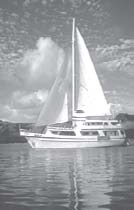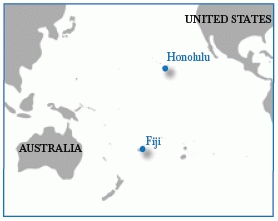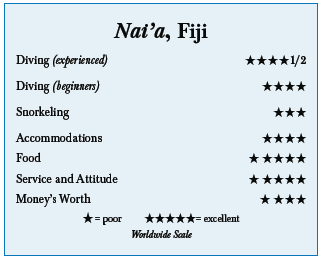Naiía, FijiContents of this Issue: Stung Divers: Skip the Vinegar, Use Hot Water The Baani Adventureís Lethal Air Compressor Bahamas, Canada, Caymans, Indonesia Three Caribbean Hubs That Leave Your Dive Bags Behind Update on the Shear Water Shark Attack Incident Nineteen Hours Adrift in Australia Poseidon Clips Its Wings In Dive Gear Recall First Itís Sharks to Fend Off, Then Itís Lethal Lizards Reader Tip: ďPadĒ Your Camera Gear Diver Charged with Killing Wife on Honeymoon Editorial Office: Ben Davison Publisher and Editor Undercurrent 3020 Bridgeway, Suite 102 Sausalito, CA 94965 bright diving, weather permitting, good service all the time from the July, 2008 issue of Undercurrent
Dear Fellow Diver: Fiji is acclaimed for the vibrant colors of its corals but it wasnít until the third day of my ten-day dive trip that I saw them. The clouds had cleared a bit when I jumped off the skiff onto a site called Mt. Mutiny. With visibility of 30 feet, I finned next to abundant yellow, gold, purple and lavender soft coral hanging from the steep wall where several white-tipped sharks lingered, and I even startled a resting turtle. Large schools of blue fusiliers and yellow damsels cascaded around me in the shallower depths. Now thatís what I had come to see.
Still, some of my dives were -- to use a colorful word here -- crappy. I learned one rule that every diver should know -- you canít predict the weather when you book months in advance. I booked my trip for early May, thinking I was safe from Fijiís official November to April rainy season, but the storms decided to hang around. I spent nearly $4,000 to dive under cloudy skies and in afternoon rainstorms. I canít fault the Naiía for that. I last dived Fiji in 2000, enjoying healthy, vibrant corals, multiple pelagics and unique critters, so at least I knew what I was missing. Many of my dives this time were bad-weather duds, but when the sun did show -- ah, the color, the color! From the moment I stepped
aboard Naiía, the Hawaiian word for
dolphin, all signs pointed to a
colorful trip. It was a veritable
rainbow at Lautoka on Viti Levuís
northwest coast Ė bright shipping
containers stacked on the docks,
golden sun, emerald hills, inviting
deep blue water. The 17 other divers were Americans, most of them a Colorado dive group. The leader owned a dive shop named Beaver Divers, a sleazy name he defended by saying the shop is based in Beaver Creek, although his business card stated Vail. After the usual get-acquainted bragging about dive experience and exotic trips, our Swiss cruise director and divemaster Sonia got us in the water for a 5 p.m. check-out dive at Samu Reef, just outside Lautoka Harbor, the boatís home port. The gray, murky site was not a good intro, but Captain Johnathan told me it would improve. After a dinner of filet mignon, green beans and roasted potatoes, we motored northeast to Bligh Water. I awoke to an orange and pink sunrise which quickly clouded over, and I barely saw the sun again for the rest of the trip. It was cloudy, windy and rained heavily on several afternoons. Nasi Yalodina, Fijiís only wreck, is a hospital ship that went down 10 years ago and slips deeper every year -- its stern is currently at 100 feet with the bow at 80 feet. I swam past large bat fish before the wreck came into view but a screaming current and an annoying wrasse that insisted on cleaning my mask made me head back to the reef, colorless in the overcast sky. At least the antics of my fellow divers were colorful as we all tried to make the
best of the ho-hum diving so far. There was a pull-up contest between 50-year-old Tony
and 75-year-old Brad, and the old guy won! The language, too, was colorful when divers
became frustrated with strong currents and murky visibility. After a difficult dive
at Catís Meow, a site with coral-encrusted swim-throughs, my buddy and I waited on the
surface in heavy swells for 15 minutes. I struggled with the boat-issued safety sausage
that wouldnít open, blew a whistle and sounded the Dive Alert, but the skiff was
merely a speck on the horizon. Sonia speaks six languages and her English is good but I often had to ask questions to clarify during announcements and dive briefings. She gave interesting, easier-to-follow lectures several mornings about reef creatures. She was great at finding the tiniest critters like crinoid shrimp. Eddie, the other divemaster, also had a sharp eye Ė he found a banded pipefish that they claim hasnít been scientifically identified so the crew named it ďNaiía pipefish.Ē The remainder of the 14-person crew, many of them veterans, were friendly Fijians who serenaded us on deck with ukuleles and guitars and put on a kava party, causing some divers to sleep through the next morningís dive. All cabins are below the main deck, accessed from the salon by a steep staircase with narrow treads -- descend backwards and hold on. There is no deck head, so after a dive one had to tackle the stairs while still wet -- an accident waiting to happen. The salon/dining area is tight; when I napped on the banquette- type benches or spread my books and computer on the tables, I had to move everything before mealtime. Thereís a wide sun deck up top, but no shade -- not a good place for paleskins. The prep deck is in the center of the boat and has lots of room to suit up and store gear in individual tubs. On the benches, dive briefings took place and divers suited up, bantering offcolor stories about Viagra, lawyers, and a joke about both. The dedicated photo room is adjacent with plenty of charging stations, shelf space and room to move. Air tanks were available for blow-drying camera equipment, along with a camerasonly wash bin. Once tanks were assigned, and BCDs and regulators set up, crew took them to the rear dive deck; I never handled my tank again. Some of the Colorado group were certified solo divers and carried several yellow pony bottles, looking like they were lit up in lights. Because everyone was using Nitrox, it took crew a longer time to fill tanks, especially the mass of pony bottles. That cut down on my air time -- sometimes I was diving with 2,800 psi instead of 3,000. Some dive times were delayed by 15 minutes because tanks were still being filled. But when underwater, I could meander on my own without having to follow a guide. The two Zodiacs were manned by Mo and Joe, both attentive and helpful, who took my tank while I was still in the water and released a sturdy ladder so I could climb aboard. Joe usually ran me back to the boat without my having to wait for other divers. Back on deck, I took advantage of two hot-water deck showers and always-ready threadbare deck towels that didnít absorb much. At the site E-6, I back-rolled into the water and was met by a huge school of barracuda before I began investigating caverns and swim-throughs covered with sea fans and soft corals, a photographerís wide-angle dream. In the rubble, I found orange and black nudibranchs and a big-eyed, red and green manta shrimp. No current and good visibility, but those vivid reds and pinks for which Fiji is famous disappeared under the cloud cover. Each morning, we made meal choices, choosing from two selections for breakfast and lunch, and three for dinner. A pre-breakfast of cereal, juice and toast was set out at 6:15 a.m.; the first of four dives followed at 7:30. Full breakfast at 9 a.m. also included fresh fruit and warm muffins, eggs, maybe a cheese frittata with bacon. After the 11 a.m. dive, I was ready for lunch - - soft fish tacos and coleslaw, sandwiches or pasta or, upon request, Chef Peni made me a crisp, creative salad. Snacks at 4:30 included popcorn, chicken satay, or sashimi. Tea, coffee, hot chocolate, fresh fruit and cookies were on hand all day. The night dive started at dusk about 6 p.m. but was skipped for the village visit, bad weather or if Captain Johnathan needed more time to get to the next site. Most dinners were excellent -- stuffed chicken breast, rack of lamb and grilled tuna with fresh vegetables. The sit-down settings featured cloth napkins and tablecloths. Wine served from carafes added an elegant touch - - the wine snob in me disliked that it came from a box though my dive buddy liked it. As we visited barrier reefs near Namena, Wakaya and Gau, we dived colorfully named sites. Mellow Yellow was named for its proliferation of yellow and gold soft coral. Golden Sunset was a first morning dive, and despite sights of a large lionfish, a good-sized white-tipped shark, and a hawkfish and a scorpionfish, I was disappointed that there was no sunlight to bring out the yellow shades of coral. But at Anthias, named for an abundance of them in magenta, orange and red, I had good visibility, mild current and I found a field of garden eels, a pale yellow leaf fish, and an enormous anemone guarded by large clownfish. Dives ranged from 30 to 90 feet, and visibility went from 20 feet on stormy days to 90 feet. Water temperatures averaged 82 degrees, which was actually much warmer than the 76-degree air above. One night, we all donned our sulus for a visit to the 132-person village of Somosomo. After a hearty ďbulaĒ greeting, the chief presided over the kava welcome ceremony. The muddy-brown brew made from pulverized root was served from a specially- carved bowl -- one clap of the hands to accept the cup and three claps to register ďvinaka,Ē thanks in Fijian. Kava is not intoxicating, but my lips were numb and I felt sleepy but happy. Village women sang and men performed a war dance. Some guests came bearing gifts. I brought first-aid supplies but a few brought gum and candy. Was that a good idea for the kids? And as soon as they were passed out, gum wrappers were scattered on the ground. Then finally! Vivid color! The sun peeked through when we hit Jimís Alley. At 30 feet, the soft corals blazed red, rust, burgundy, pink and purple. Burnt-orange sea fans waved to me. I saw two large carpets of red anemones (the only site in Fiji where they live, I was told) filled with orange anemone fish. I swam among striped surgeon fish, coral groupers, magenta and yellow dottybacks, iridescent parrotfish and a blue ribbon eel. Lack of sun didnít dent the premier dive site, Nigali Passage. The swift current dive featured schools of barracuda, snappers and big-eyed jacks, dozens of five-foot gray reef sharks and a grouper as big as dual 80s. It hung around on the sandy bottom, posing for photos. A giant clam decked out in purple soft coral sat near a patch of pristine, pale yellow lettuce coral. Banded sea snakes, Moorish idols, yellow needlefish and butterflyfish mingled. Signs of coral bleaching and weather-caused reef damage are present but Fijiís reefs, walls and pinnacles are alive and regenerating. To experience them in full Technicolor, come between May and October when itís cooler and drier. Although as global warming is changing the reefs, it may also be making the rainy-season timeframes unpredictable. Naiía gets high marks for safety, crew-to-passenger ratio, food quality and service. At $4,200 per person for a ten-day trip, youíre certainly going to pay for it, but Iím one of many return guests who come for the frequent-diver discounts and the friendly coddling. I like the divemastersí respect for marine life and a conservation- conscious dedication to preserving it. Naiía has some minor inconveniences that could be improved, but for divers wanting an upscale trip in the Pacific, itís top-notch. -- S.M.
|

I want to get all the stories! Tell me how I can become an Undercurrent Online Member and get online access to all the articles of Undercurrent as well as thousands of first hand reports on dive operations world-wide
| Home | Online Members Area | My Account |
Login
|
Join
|
| Travel Index |
Dive Resort & Liveaboard Reviews
|
Featured Reports
|
Recent
Issues
|
Back Issues
|
|
Dive Gear
Index
|
Health/Safety Index
|
Environment & Misc.
Index
|
Seasonal Planner
|
Blogs
|
Free Articles
|
Book Picks
|
News
|
|
Special Offers
|
RSS
|
FAQ
|
About Us
|
Contact Us
|
Links
|
3020 Bridgeway, Ste 102, Sausalito, Ca 94965
All rights reserved.


 My consolation
when surfacing from murky dives was that I was pampered aboard a well-run, luxury
dive boat. Naiía is a 120-foot steel-hulled
motorsailer built in the mid 70s -- Rob Barrel
and sister Alexx Edwards turned it into a liveaboard
catering primarily to Americans. The
mainsail was partially raised for stabilization
but the boat was powered by motor for the trip.
Nine cabins with private heads and individual
A/C accommodate 18 divers. My clean cabin had
two portholes, ample shelf space, and plenty
of room to walk around. On the queen bed was a
bright patterned sulu, a Fijian sarong to wear
around the boat, but I wish I had had more than
one pillow to prop myself up for reading. My
shower was big enough for two but a grip bar
would be good in case the boat lurches.
My consolation
when surfacing from murky dives was that I was pampered aboard a well-run, luxury
dive boat. Naiía is a 120-foot steel-hulled
motorsailer built in the mid 70s -- Rob Barrel
and sister Alexx Edwards turned it into a liveaboard
catering primarily to Americans. The
mainsail was partially raised for stabilization
but the boat was powered by motor for the trip.
Nine cabins with private heads and individual
A/C accommodate 18 divers. My clean cabin had
two portholes, ample shelf space, and plenty
of room to walk around. On the queen bed was a
bright patterned sulu, a Fijian sarong to wear
around the boat, but I wish I had had more than
one pillow to prop myself up for reading. My
shower was big enough for two but a grip bar
would be good in case the boat lurches. Finally my buddy ripped the sausage with his knife to
get it inflated and we were picked up.
When I showed Sonia the ripped sausage
and said, ďThis is a piece of s**t,Ē
her response was, ďEverybody should dive
with one.Ē Huh?
Finally my buddy ripped the sausage with his knife to
get it inflated and we were picked up.
When I showed Sonia the ripped sausage
and said, ďThis is a piece of s**t,Ē
her response was, ďEverybody should dive
with one.Ē Huh?  Diverís Compass: I arranged my trip, including hotel in Nadi,
directly with Naiía . . . Ten days cost $4,200 and includes marine
park fees and transfers between airport or hotel and the boat;
seven-day trips are $2,940 . . . Naiía offers a return-diver discount
of $200 for the first return trip, and an additional $100
discount for each trip thereafter, for a maximum discount of $1,000
for the 10th return trip . . . Closest chamber is at Suva but the
helicopter doesnít fly at night so donít get bent on a night dive.
. . . Nitrox is $7 per day; soft drinks are complimentary as are
beer and wine with dinner; hard liquor is $5 and the excellent trip video is $95
. . . On-board charges, including tips, are better to be settled in cash because
Naiía annoyingly imposes a 3 percent surcharge on credit cards (which my Nadi hotel
didnít do) . . . Air Pacific (a partner of American for mileage purposes) flies
from LAX on a daily code-share flight with Air New Zealand and Qantas, and fall
fares were recently priced at $1,150; however, Naiíaís Web site says they can offer savings on international air fares . . . Naiíaís online newsletter in October 2007
announced that the boat is for sale; one crew member I asked about this didnít
seem concerned, believing itís unlikely the Naiía will leave Fiji . . . Naiíaís Web
site:
Diverís Compass: I arranged my trip, including hotel in Nadi,
directly with Naiía . . . Ten days cost $4,200 and includes marine
park fees and transfers between airport or hotel and the boat;
seven-day trips are $2,940 . . . Naiía offers a return-diver discount
of $200 for the first return trip, and an additional $100
discount for each trip thereafter, for a maximum discount of $1,000
for the 10th return trip . . . Closest chamber is at Suva but the
helicopter doesnít fly at night so donít get bent on a night dive.
. . . Nitrox is $7 per day; soft drinks are complimentary as are
beer and wine with dinner; hard liquor is $5 and the excellent trip video is $95
. . . On-board charges, including tips, are better to be settled in cash because
Naiía annoyingly imposes a 3 percent surcharge on credit cards (which my Nadi hotel
didnít do) . . . Air Pacific (a partner of American for mileage purposes) flies
from LAX on a daily code-share flight with Air New Zealand and Qantas, and fall
fares were recently priced at $1,150; however, Naiíaís Web site says they can offer savings on international air fares . . . Naiíaís online newsletter in October 2007
announced that the boat is for sale; one crew member I asked about this didnít
seem concerned, believing itís unlikely the Naiía will leave Fiji . . . Naiíaís Web
site: 